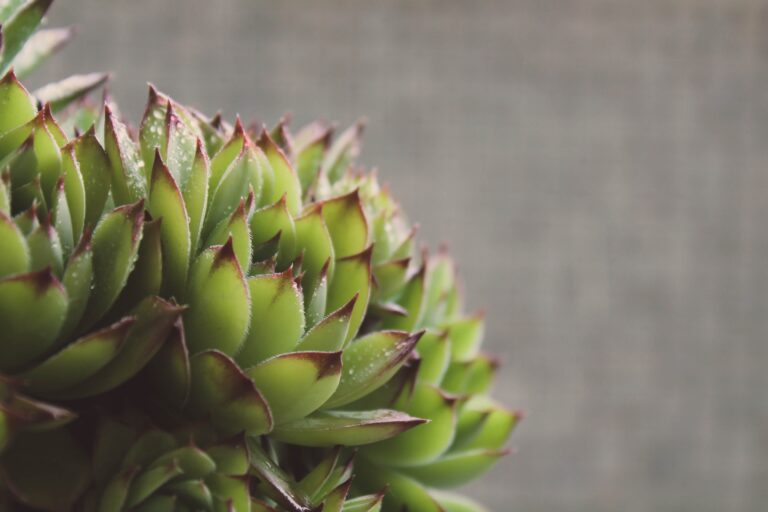Introduction to Sempervivum Montanum
Welcome to the rugged world of Sempervivum Montanum, a plant that laughs in the face of harsh climates and blooms with a simplicity that captures the heart of any garden enthusiast. Born in the high altitudes of Europe, this succulent has made a name for itself as the mountain tough-guy of the rock garden arena. But don’t let its resilience fool you; nestled among craggy rocks and gravelly soil, ‘Sempervivum Montanum’, with its symmetrical rosettes, weaves an aesthetic of understated elegance into the landscape.

For those with a penchant for gardening with a twist, incorporating this hardy perennial into your garden design is not only a statement of style but also an ode to practicality and durability. Imagine an almost self-sustaining plant that calls for minimal fuss – yes, ‘Sempervivum Montanum’ demands very little but gives back generously in the form of rich, green rosettes and the promise of new growth each year.
It doesn’t stop there; this enduring succulent has a fan base that extends beyond the traditional gardener. The intricate design of ‘Sempervivum Montanum’s leaves, which spiral into perfect geometry, has captivated many a rockery collector. These little marvels are more than just plants; they are living sculptures that accentuate any rock garden or alpine collection, ushering in an artistic resonance that echoes the beauty of their highland origins.
Why not learn more about the unfussy care that ‘Sempervivum Montanum’ thrives on? Discover the safeguarded secrets that have armed ‘Sempervivum Montanum’ with the resilience to prosper year after year, whether they’re basking in the generous embrace of the sun or weathering the bite of frost under the moonlit sky.
Anatomy of Sempervivum Montanum
Have you ever encountered a plant so resilient, it can thrive on a sheer mountain face or brighten up your rock garden with minimal fuss? Welcome to the world of Sempervivum montanum, commonly known as ‘Mountain Houseleek’.
Sempervivum montanum is nature’s equivalent to a survivalist, boasting fleshy, water-storing leaves that form captivating rosettes—a perfect union of form and function. Visualize a green spiral that’s crafted to perfection, with leaves that taper to a point like an artist’s finest brush strokes.
When in bloom, this botanical marvel unveils flowers that seem to capture the very essence of the mountains from whence it hails. Imagine walking through alpine meadows as a plethora of pink, star-shaped blossoms emerge, a true spectacle of natural beauty.
Understanding the unique anatomical structure of Sempervivum montanum is essential for any plant enthusiast. For an insightful read on how to cater to the preferences of these hardy succulents, reference this detailed guide on their care.
Next time you spot a Sempervivum montanum, take a moment to admire its evolutionary artistry. The secrets to its success are etched in every leaf and bloom, a testament to the resilience and splendour of flora. Embrace these mountain beauties in your garden, and let them tell their own remarkable story of survival and triumph.
Essential Care Tips for Thriving Plants
Let’s dive right into nurturing your Sempervivum Montanum, a gem of mountainous origins, perfect for adding a touch of alpine majesty to your garden. From sunny spots to watering wisdom, let’s decode the growth formula for these resilient rosettes.
Sunlight: Nature’s Kiss
Full sun is the mantra for your Sempervivum Montanum. Picture these hardy plants basking on a rocky slope, soaking up all the high-altitude sun they can muster. In your garden, seek out a spot where the sun plays generously for at least six hours daily, ensuring your plants get the golden glow they need to thrive.
Watering: A Delicate Dance
Imagine the sporadic downpours that refresh mountain flora; this is the rhythm to mimic. Overwatering? Not on the checklist. Wait patiently for the soil to dry out completely between watering sessions. That’s when your Sempervivum Montanum whisper their thirst. Heed their call with moderation, for their roots are experts at retaining moisture, much like their cousins you can learn about in this comprehensive succulent care guide.
Soil Preferences: Their Rocky Romance
The perfect substrate for Sempervivum Montanum? Think of a mix that echoes their highland heritage—gritty, well-draining, and unapologetically porous. A coarse sand and peat combination, breathy and light, allows roots to anchor without the dread of waterlogging.
Other Key Factors: The Alpine Ensemble
Temperatures plummeting and frost setting in? No need to fret. Sempervivum Montanum are the highlanders of the plant world, donning their natural anti-freeze armor against the cold snaps. In the heat of summer, though, make sure the breathability of their soil stage keeps their roots cool and composed.
Feed them but keep the menu light—a low-nitrogen diet fit for a minimalist mountaineer suffices. This way, you dodge the curse of overgrown foliage at the expense of their iconic rosettes. And pests? Simply a no-go, as Sempervivum Montanum flaunts their resilience against common garden marauders.

Embrace these tips, and watch as your Sempervivum Montanum transforms your garden into a miniature alpine escape. Sunlight, water, and soil—the holy trinity of care—unite to choreograph a splendid display of mountain beauty, right in your backyard.
Planting and Propagation Techniques
Hey green thumbs, ready to climb the mountain of gardening success with Sempervivum montanum? Nestle into your seats, because we’re about to embark on a step-by-step expedition on planting and propagating these alpine marvels, transforming your garden into a peak of beauty!
Choosing the Perfect Spot
First off, you’ll need to pick the perfect plot. Sempervivum montanum, also known as Mountain Houseleeks, cherish the sun like they’re basking in their native high-altitude glory. A spot that’s blessed with abundant sunlight and well-draining soil will make them feel right at home. Envision them perched on a rocky ledge; replicate that, and they’ll be thriving in no time!
The Planting Process
Rolled up your sleeves? Great! Now, let’s get hands-on with the soil. If your garden’s more clay than a potter’s workshop, amend it with sand or gravel to ensure impeccable drainage. When you’re set, dig a hole just deep enough so that the root ball sits snugly at soil level. Tuck your Sempervivum montanum in, fluff the surrounding soil lightly, and give them a courtesy sip of water – they’re drought-tolerant, so no need to flood their new abode.
Mastering Propagation
Propagation is where the real fun begins, turning one plant into a mountain range of mini replicas! These succulents reproduce by offsets, little plantlets that sprout from the mother plant’s base. When they’ve grown a bit, gently twist them off and let them callous over for a day or two. This dry rest period is like a meditation retreat for plants, prepping them for their solo journey.
Once they’ve achieved zen, nest the offsets into a shallow bed of slightly damp soil. Place them in a sunny, cozy corner where they can bask but not bake. In just a few weeks, roots will tentatively reach out, securing their new home in your garden. And voilà, your Sempervivum montanum collection is expanding like a well-curated mountaintop retreat!
Watch this engaging video to see a real-life example of how these majestic plants spread their wings – or, well, their leaves. It’s a visual treat that will surely give you that extra boost of confidence to start your own propagation project.
Pests and Problems: Prevention and Solutions
Imagine you’re basking in the glory of succulent gardens, admiring the resilience of these green warriors like the Sempervivum montanum nestled among them. But even the mightiest of plants can face the trials of nature’s pesky intruders and disease. Let’s gear up for a deep dive into safeguarding the mountain-dwelling beauty in your backyard.
First on our list of uninvited guests are aphids, those tiny critters with a sweet tooth for your plants’ sap. They’re not just enjoying a meal; they’re potentially spreading viruses, too. Combat these pests by introducing natural predators like ladybugs or applying a gentle shower of soapy water. The key is consistency and early detection.
Common Culprits: Identifying Pest Infestations
Then there’s the root-eating nematode, a microscopic roundworm causing havoc below the surface. Their presence is often under the radar until poor growth or yellowing leaves raise a red flag. Nematodes fancy high moisture, so maintaining proper drainage can put a damper on their parade.
Have you spotted any chewed leaves or munched flowers? The suspect could be weevils, notorious for their nocturnal feeding sprees. Hand-picking can keep their numbers in check, but for a large-scale infiltration, it may be time to consider environmentally friendly insecticides or traps with a dash of patience.
Defeating Diseases: Tackling Fungal Foes
When it comes to diseases, the biggest offender is often fungal in nature, such as powdery mildew casting a ghostly pallor over your Sempervivum montanum. Ensuring good air circulation and avoiding overcrowding can keep these spores at bay. Should the mildew make its mark, fungicides are your friend, but be mindful of the types – organic options are out there!
Where there’s dampness, there’s a chance for the dreaded rot to set in. Those soft, mushy parts at the base aren’t just unpleasant; they’re a death sentence if unchecked. The rot stopper? Proper watering practices paired with well-draining soil can spell disaster for the destroyer and ensure your Sempervivum montanum’s survival.
Let’s face it, dealing with pests and diseases can feel like a battleground, but with these proactive practices, your sempervivum will continue to stand tall, a testament to your vigilant care. For a visual guide on nurturing these hardy succulents, check out this handy video:
Remain vigilant, fellow gardeners, for with knowledge and swift action, our Sempervivum montanum and its companions will thrive, creating a mountainous masterpiece right in our gardens.
Landscape Design Ideas with Sempervivum Montanum
Anyone who’s peeked over the fence into a neighbor’s garden and spotted a lush, living tapestry on a rock wall has likely had their first enchanting encounter with Sempervivum montanum. Commonly known as the Mountain Houseleek, this succulent is not just hardy and low-maintenance; it’s a showstopper in creative landscape designs. Let’s dive into the world of rock gardens, green roofs, and xeriscaping with this mountain gem.
Rock Gardens: A Symphony in Stone
Picture a gentle slope in your backyard, now imagine transforming it into a multilayered rock garden starring the resilient Sempervivum montanum. The trick is to mimic its natural alpine habitat, with well-drained soil and plenty of sunshine. Nestle these rosette-forming plants among boulders and gravel paths, creating pockets of life that accentuate the rugged beauty of the rocks. Not only will they thrive, but they’ll also invite a splash of green that ripples across the stony landscape, blooming with pink flowers that are a buzz with pollinators in the summer.
Real-life example: There’s a home in the Swiss Alps that takes the phrase ‘living in the mountains’ to a literal level. The front garden is a slope of carefully arranged rocks with sweeps of Sempervivum montanum anchored firmly in the crevices. It looks as if the mountain itself decided to sprout succulents!
Green Roofs: Elevation with Vegetation
Why not look up for inspiration? Green roofs with Sempervivum montanum aren’t just eye candy; they’re eco-friendly too. They provide excellent insulation, create habitats for wildlife, and help manage stormwater. These plants’ shallow root systems and drought tolerance make them perfect candidates for rooftop gardens where space is a premium and conditions can be challenging.
Take the example of a local library whose green roof bursts with the verdant vibrancy of the Mountain Houseleek. It’s a living, breathing book of nature perched atop a cultural haven, echoing the stories within its walls with a serene green narrative.
Xeriscaping: Low Water, High Impact
Embrace the art of xeriscaping by using Sempervivum montanum to conserve water without sacrificing aesthetic appeal. Xeriscaping focuses on selecting plants that require minimal irrigation, perfect for eco-conscious gardeners or those in dry climates. With its succulent leaves, Sempervivum montanum stores water, ensuring it stays lush even when the skies are stingy with rain.
A stunning example is a xeriscaped yard where these plants not only survive but thrive, creating a rich, textured canvas that’s both water-wise and wonderfully attractive. Amidst the pebbles and sand, the green and burgundy rosettes emerge like jewels, proving that drought-tolerant landscaping can be both beautiful and responsible.
And to truly visualize the potential of incorporating Sempervivum montanum into your landscape, we invite you to watch this video that brings the concept to life:
The rugged allure of Sempervivum montanum is undeniable. Whether on a rockery, a roof, or a xeriscape approach, this succulent reminds us that beauty can be found in resilience, and that even the most barren environments can bloom with life when we plant wisely. Nature is the ultimate landscape artist, and with Sempervivum montanum, we can all have a piece of that wild, natural elegance in our gardens.
Environmental Benefits and Ecosystem Role
Let’s dive into the world of Sempervivum montanum, a resilient alpine succulent that not only embellishes our gardens but also serves as an eco-warrior in its native habitat and beyond. Imagine a tapestry of these hardy plants, with their impeccable rosettes, spilling over rocky terrains and bringing life to areas where few plants can thrive. But their role extends much further than their aesthetic appeal.
Planting Sempervivum montanum, affectionately known as ‘mountain houseleeks,’ comes with a bouquet of environmental perks. These botanical saviors help combat soil erosion with their thick, fleshy leaves and robust rooting system. On steep slopes and barren garden spots, they’re like miniature green architects, securing the soil and providing a stronghold for other plant species to take root. Their presence is a testament to nature’s ingenuity in stabilizing the environment.
In their native ecosystem – the mountainous regions of Europe – these succulents play a pivotal role. Amidst rocky crags and alpine meadows, Sempervivum montanum contributes to biodiversity by offering nourishment and refuge to a variety of insects and small animals. The flowers, although less conspicuous than the iconic rosettes, are a banquet for pollinators, ensuring that life buzzes even at high altitudes.
Imagine the transformation when these floral emblems of resilience are introduced into domestic gardens. They become mini-ecosystems, inviting beneficial insects that become natural pest control agents, reducing the reliance on harmful chemicals. Furthermore, as water-wise plants, they demand little in terms of resources, encouraging gardeners to adopt more sustainable practices and reconsider their environmental footprint.
But it’s not just their environmental prowess that makes them a gardener’s ally. These plants are storytellers, tracing the history and health of their surroundings. An abundance of Sempervivum montanum might indicate a well-balanced local ecology, whereas a decline could signal environmental issues, urging us to pay closer attention to the land we share.

Taking a moment to appreciate Sempervivum montanum is taking a moment to connect with a wider ecosystem. These plants don’t just survive; they thrive with a purpose, enriching our planet in discrete yet significant ways. By integrating these mountain beauties into our gardens, we aren’t just cultivating plants; we’re empowering an environmental legacy, leaf by succulent leaf.
Frequently Asked Questions
Ever gazed at the rugged peaks of a mountain and witnessed the unassuming charm of the Sempervivum montanum nestled in its rocky embrace? This alpine beauty isn’t just for high altitudes; it’s also a resilient addition to any garden, where its symmetrical rosettes add a touch of wild perseverance. Let’s dive into some common questions garden enthusiasts like you often ponder about this mountain gem.
When does Sempervivum montanum typically bloom?
Timing is everything, they say, and the Sempervivum montanum seems to agree. Donning its best attire typically in the summer months, its blooms are a rare sight that not every gardener gets to behold. If you notice your sempervivums sprouting a tall, floral stalk, congrats—that’s a bloom in the making! Just remember, these plants are the ‘live once, bloom big, then die’ sort.

How do I care for Sempervivum montanum during winter?
Think of the Sempervivum montanum as the winter warrior of the garden. Originating from chilly mountain regions, it weathers the winter with stoic indifference. The trick is to mimic its natural habitat—well-draining soil is a must to prevent its feet, I mean, roots from getting cold and wet. Consider these plants the ‘set it and forget it’ type, perfect for the gardener who appreciates low maintenance character.
Are they friendly neighbors to other garden plants?
Imagine a glorious patchwork quilt—each patch distinct yet contributing to a magnificent whole. That’s your garden, with Sempervivum montanum included. This succulent is not just a mountain’s companion but gets along splendidly with other plants. It’s non-invasive, giving room to its peers, like the delicate columbines or the robust sedums, forming a tapestry of textures and colors. Remember, diversity in your garden is like a good party—vital for an engaging atmosphere.



